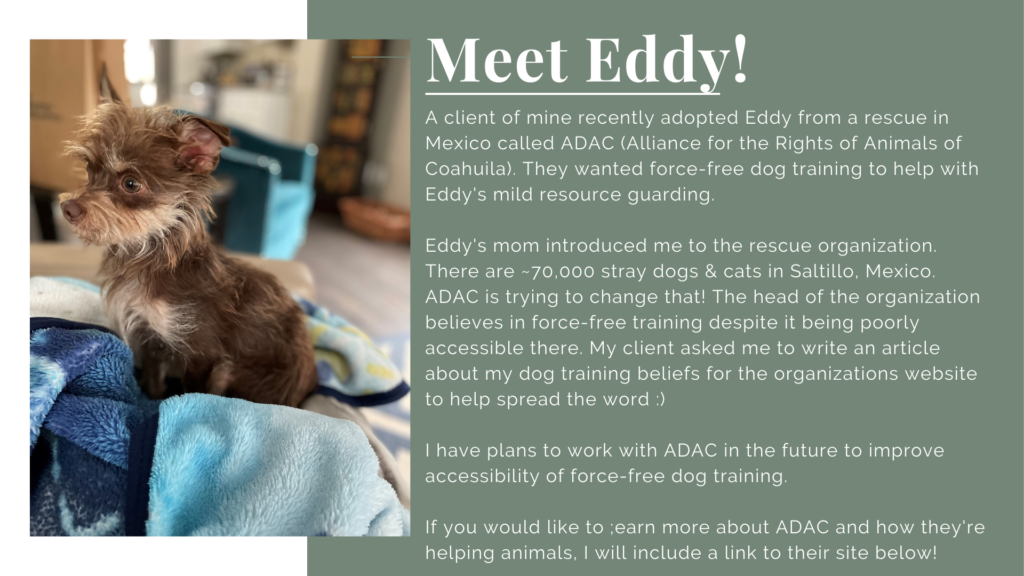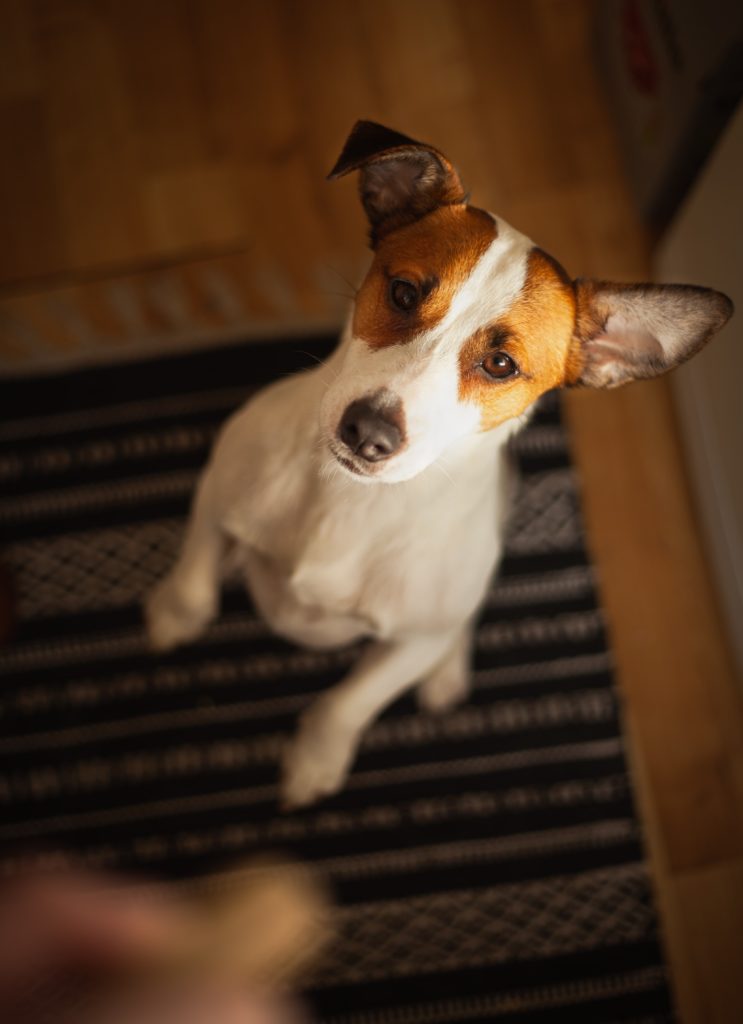
The dog training industry needs to change. Methods that use fear, pain, intimidation or force to “train” dogs are outdated and harmful. I would like to explain why I believe punishment-based training is unfair, and why force-free dog training is the future.
First: do you want to hear an upsetting and surprising fact? Dog training is not a regulated industry. Anyone can decide to call themselves a dog trainer. There are many amazing organizations and individuals working to change that, but regulation has not happened yet.
I feel like that’s important to know in our age of easy-information-access. That “expert” you’re seeing online may have zero training or knowledge about dogs. Simply “working with dogs for years” does not make one an expert. It’s very possible to practice the wrong thing over & over, so duration of practice does not necessarily mean actual skill.
Imagine if you needed a doctor. Would you prefer medical advice from someone who has a medical degree and formal knowledge, or would you just want advice from that guy on social media who has strong opinions?
Perhaps you should consider the same thing when you’re looking for dog training advice!

Years in the industry does NOT necessarily equate to good advice.
Dog training advice is everywhere these days. It seems like with a quick Google search or scroll of social media you can find the answer to anything you want to know about your dog! This is amazing in many ways because it allows everyone to access information that might be helpful. The dark side of it however is that anyone can call themselves a dog trainer and post whatever they want as “advice”. I see videos daily of “trainers” suggesting cruel, harmful practices in the name of dog training. It’s hard not to feel upset when terrible information spreads virally. The dogs are the ones who suffer.
I became a dog trainer because I love dogs & want to help change the industry. A common theme you’ll notice is that force-free dog trainers WANT industry regulations, whereas balanced dog trainers do not. Why? The simple answer is that no one who understands dog behavior and loves dogs would choose balanced training methods. Therefore, regulation would threaten their incomes.
Countless studies show that positive reinforcement dog training is the most effective. Studies have also shown that using aversive methods (such as shock, choke, and prong collars or heavy corrections) causes dogs stress, fear, and pain.
Force-free training works better while also causing less anguish for the dog. In a regulated industry, force-free training would be the accepted method.
So why does balanced training even exist?
Where did dog training go wrong?
Have you heard of dominance or alpha theory? It’s an incredibly unfortunate theory that was developed in the 1930’s and has forever changed how dogs have been treated. The worst part is that it’s been debunked. It was never true in the first place!
In the 1930s Swiss scientists were studying zoo wolves. They noted that the wolves would fight for dominance. The terms “alpha wolf” and “pack leader” began.
In the 1960s a renowned scientist named Dr. Mech wrote a book agreeing with the concept. His work went mainstream and became wildly accepted as true. His research was extrapolated from wolves to dogs. All of a sudden if your dog was misbehaving they must be trying to be the “alpha” and needed to be shown their place. Ludicrous concepts such as alpha rolling your dog, making sure you eat first to show them you’re pack leader, or using a heavy hand to put them in their place became mainstream.
Two gigantic research issues that no one noticed at first:
- Everything was based on watching wolves in zoos, which act nothing like wolves in the wild.
- Dogs may have descended from wolves, but they are not the same. That’s like comparing humans to apes.
Wild wolves form families. There is little aggression or fights. In fact, they depend on each other for survival!
Somehow this misguided information about wolves has been used for decades to justify abusive dog training methods.
Balanced trainers like Caesar Milan became so mainstream that the abuse they suggest as “training” has been widely accepted. Putting dogs in situations where they’re over threshold so they act poorly (often on camera) then punishing them until they shut down is NOT proper training. Yet many people still believe that this is the only way to train a dog!
In the 2008, Dr. Mech himself stated the previous research was wrong. Yes, THE scientist that wrote the theory in the first place admitted it’s incorrectly used.
Yet, cruel dog training methods continue to this day. The inaccurate dominance theory won’t die.
I aim to be part of the movement away from “balanced” dog training. I hope by reading this article you’ll make the same choice when it comes to training your dog!

The difference between “balanced” and force-free dog training:
I fully agree that there are many effective ways to train your dog. However, NO training method should use fear, pain, or intimidation as a technique.
At it’s simplest form, dog training uses operant conditioning or “learning by consequence”. Consequence might sound negative, but there are both enjoyable and unpleasant consequences.
If a dogs behavior has an enjoyable consequence they will want to repeat it. An example is when you ask your dog to sit, and then give him a treat when he does.
Dog: I put my butt on the ground and I got something delicious! I will put my butt on the ground more often!
If a dogs behavior has an unpleasant consequence it will happen less often. An example would be jerking on your dogs collar when they pull on the leash.
Dog: When I walked in front my neck hurt. I don’t like my neck hurting. I won’t walk in front next time.
Force-free (also referred to as positive-reinforcement based) dog training sets your dog up for success.
It involves teaching the dog to make the right choice by rewarding what we like (such as offering a treat for sitting). Positive reinforcement training uses a reward (treats, praise, toys, anything the dog finds rewarding) to promote desired behaviors. Force-free training doesn’t use physical force to make dogs do things. Dogs are put in situations that are fair, and they are taught the proper skills using rewards. This results in engaged, happy canine learners.
Now, what about balanced dog training? “Balance” sounds like a good thing….. right?
However, balanced dog training often uses positive reinforcement along with physical punishment. This can be highly stressful (and even painful or scary) for your dog.
Leash jerks, choke & prong collars, or electric shock might suppress a behavior you dislike in that moment, but they do not teach your dog what they SHOULD do instead. Harsh corrections can lead to very stressed, scared and shut down dogs because they’re constantly concerned about doing the wrong thing and being punished again.
Imagine how nervous you would feel around someone who physically punished you for “mistakes”. Now imagine if you also had never been taught the “correct” way, so you had no way to avoid making those mistakes. It’s constant stress.
Punishment-based “balanced” dog training is not humane or fair way to teach new skills.
Force-free, positive reinforcement based training results in dogs that are better trained without causing unnecessary stress, fear, or pain.
Since you can train without inflicting mental or physical harm on your dog, why WOULDN’T you choose that?
There continues to be people (and trainers) that do not believe a dog can be properly trained without corrections. Let me explain why this is wrong.
Dogs do not need to get something wrong and be “corrected”:
Sometimes we get so used to a concept or technique being “normal” that we never ask if it’s wrong. Let’s look at how unnecessary punishment-based balanced dog training is.
Here are examples of two different methods of teaching the same thing. Which would you prefer?
Example 1- Punishment based training:
Let’s say that you and I are going for dinner. You need to learn my favorite food.
You’ve never dined with me before and have no idea what food I even like.
Instead of telling you, I decide we should play a game.
I ask you to guess which item on the menu is my favorite food.
You look down at the massive menu and have no idea. Oh well! You guess spaghetti?
No, I hate spaghetti.
All of a sudden I bring out a electric prod and zap you in the neck for guessing incorrectly.
Next guess? Are you a little hesitant to even speak?
You don’t have a choice but to try again…. I’m expecting you to learn what my favorite food is!
You try to guess better to avoid pain. I didn’t like spaghetti, so maybe I don’t like noodles?
You guess that steak is my favorite….
Wrong! Since you’ve gotten it incorrectly a second time I zap you a little harder. Why haven’t you learned my favourite food yet?!?
How many wrong guesses would be required before you are too scared to try again?
Punishment does NOT result in you just “knowing” the right answer. It’s a terrible way to learn!
You finally guess burgers right on the 7th try. Your neck hurts and you’re scared.
How comfortable would you be around me after that? If I wanted to teach you something in the future, would you want to learn from me?
This is exactly what using a shock collar to train your dog is like. You haven’t taught them the right “response”, yet you punish mistakes. Using physical punishment to train is inhumane and unfair.
How else could you teach my favorite food though?!
Example 2- Positive-reinforcement dog training:
The scenario starts the same way.
You and I are going for dinner. You need to learn my favorite food.
You’ve never dined with me before and have no idea what food I even like.
Instead of telling you what my favorite food is I decide we should play a game.
I ask you to guess what item is my favorite on the menu.
When you look at the menu this time, it looks a little different.
The only option on the menu is a burger.
Slightly confused, you guess burger? I reward you for being correct with a bite of cake!
Another menu comes out, and this time it shows either a burger or spaghetti.
You already know burger is the right choice, so you guess that.
Another piece of cake!
We can continue to progress your learning until the menu is exactly the same size as example 1. However, in this scenario you’d know exactly which item to pick because we’ve practiced progressively more difficult scenarios.
Which version would you rather play?
Can you guess which one your dog would like more?

This is exactly why positive-reinforcement, force-free dog training is the future.
By starting in situations where our dogs can make successful choices (and rewarding those choices!) they can learn anything!
There’s an odd stigma that force-free dog training is permissive or results in a poorly trained dog. This simply is not true. My expectations for my dogs are high, but I also teach those skills in fair & fun ways. I think the best kind of training is the style that results in both the dog owner and the dog feeling bonded and happy.
There’s also a fallacy that certain breeds (such as shepherds, rottweilers, huskys, etc) require a heavy hand to be trained. For whatever reason, some people do not believe that these larger working breeds can be trained with force-free positive reinforcement methods. This is not true at all! Positive reinforcement is used to train species ranging from bunnies, birds, cats, and all the way to killer whales in aquariums! Dogs have been bred for many years to co-exist with humans. Does it make any sense that a large dog would require harsher training methods than a killer whale?
Please consider force-free methods if you’re training your dog!
I hope that I have persuaded you to consider using more humane methods to train your dog. If you’re searching for help, try to find a force-free dog trainer in your area. There are also many amazing resources available for free online!
We owe it to our dogs to train them nicely and practice caution in where we get our advice.
The more informed dog owners are about their options the more pressure there will be on the industry to drop outdated, harmful methods. This makes me excited to see how the dog training industry changes over the next decade!
Happy training 🙂
Disclosure: Happy Hounds uses affiliate links. Purchasing with these links will not cost you any extra, but I get commissions for purchases made through these links. Affiliate links help me to continue to offer free resources & blog posts. I would love if you used them!


Eddy’s mom here! A big thank you goes out to Happy Hounds Dog Training on behalf of Eddy, and many other Mexican dogs that will benefit from force-free dog training. You’re giving street dogs a chance to live in a safe, calm, peaceful home. Muchas gracias!!
Hi Laura! Thank you so much for the kind words 🙂 I really appreciate the work you’re doing with the rescue. I’m happy to be able to do my small part in raising awareness and information. I look forward to continuing to help in any way that I can!
Im very pleased to find this site. I need to to thank you for ones time for this particularly fantastic read!! I definitely really liked every part of it and I have you bookmarked to see new information on your site.